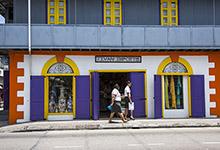
Typical street scene in Santa Ana, El Salvador. (Photo: iStock)
IMF Survey : Seychelles Marks Five Years of Successful Economic Transition
December 20, 2013
- Then: interventionist economy, debt crisis, shortages of goods
- Now: market based, full employment, fiscal surpluses, rising reserves
- Economy’s resilience to external shocks still needs further strengthening
With yesterday’s approval of the final review of its IMF-backed economic reform program, Seychelles marks a major milestone in its transition from a crisis-ridden, interventionist economy to one that is more stable and private sector led.

Store in Victoria, Seychelles, where economic reform measures included steps to unleash private sector growth (photo: Jon Arnold/JAI/Corbis)
SMALL ISLAND ECONOMIES
Five years ago, the country was struggling with seemingly insurmountable problems: an overvalued fixed exchange rate, plummeting foreign exchange reserves, a bloated and pervasive public sector, and an unsustainable debt burden—all in the midst of the global financial crisis.
On October 31, 2008, President James Michel announced a reform program that liberalized the exchange rate regime, slashed public spending and employment, and redefined the role of the state in the economy. At a conference on the anniversary of the announcement in 2013, Michel described the reform program as “one of the most complete and comprehensive macroeconomic and structural reform programs that the world has experienced in recent times.”
Since independence in 1976, Seychelles had achieved considerable economic and social progress, supported by a growing tourism sector. However, imbalances began building in the 1990s, as a result of high public spending and loose monetary policy in the context of a fixed exchange rate and pervasive exchange controls. By 2007, the fiscal deficit reached 8 percent of GDP, public debt 131 percent of GDP (two thirds of it foreign), and reserves fell to two weeks of imports.
Signs of crisis
When 2008 brought food and fuel price shocks and the onset of the global recession, the situation became untenable. At the recent conference, Michel noted “the signs were there for all to see. An overvalued rupee, empty shelves in the shops, a flourishing black market, queuing up to buy $400 for travel overseas… we could no longer honor our commitments to our international creditors…”
The stage was set for deep and comprehensive reform program, with support from the IMF and other partners. The exchange rate floated, all exchange restrictions were eliminated, and a strong fiscal adjustment occurred, including a 15 percent reduction in public sector employment. Steps to promote long-term growth included simplification of the tax system and reducing constraints on private sector growth. The authorities’ efforts were backed by balance of payments support of 15 percent of GDP and a debt restructuring with external creditors that reduced the present value of their claims by almost 50 percent.
Reform results
Determined implementation of these comprehensive reforms bore fruit over the next five years. Unemployment returned to low historical levels after a short uptick; the exchange rate recovered after briefly overshooting; reserves grew from half a month to over 3½ months of imports; and public debt nearly halved by the end of this year (to 72 percent of GDP), thanks to debt restructuring and primary fiscal surpluses averaging 7 percent a year. The Governor of the Central Bank of Seychelles, Caroline Abel, underscored how reforms also boosted “confidence in the domestic economy, which has improved the investment environment.”
President Michel heralded his country’s successful transition: “Seychelles is today respected as a nation which has done the right thing. We have a track record that is recognized by the international community at large.” The Seychellois Minister of Finance, Trade and Investment, Pierre Laporte, has held up the country as a case study of successful reforms in a small island economy.
Seychelles’ success highlights the importance of strong ownership, public communication, and measures to protect the most vulnerable. The authorities carefully explained the rationale for the reform measures and strengthened the targeted social safety net while abolishing universal price subsidies.
Capacity limits
To offset the limits on Seychelles’ institutional capacity from its small size, the IMF and other partners provided significant technical assistance, notably on an independent monetary policy, comprehensive tax reform (particularly the introduction of a value-added tax and a flat-rate personal income tax), and statistics.
At the conference, IMF African Department Deputy Director David Robinson declared Seychelles’ achievement as a “tremendous turnaround.” The incoming IMF mission chief, Marshall Mills, highlighted that “Seychelles’ ability to implement such a wide-ranging program of reform while preserving social stability is truly impressive.”
Even with all the progress, Robinson also stressed that Seychelles’ open, small island economy remains highly vulnerable. He pointed to the need to further strengthen the economy’s resilience to external shocks through reducing the still high debt levels, strengthening reserves, and limiting the potential fiscal risks posed by the parastatals.
Stakeholders at the conference supported the priority placed on macroeconomic stability and inclusive growth. Laporte highlighted the need for continued structural reforms to sustain economic gains and boost incomes. Stakeholders broadly agreed, while offering a range of opinions on the importance of different measures.
The authorities have indicated their intention to request a successor program to buttress their continued progress. Though the current four-year Extended Fund Facility came to an end yesterday, Robinson emphasized the IMF will continue to support Seychelles intensively as it embarks on the next stage of its development and growth.


